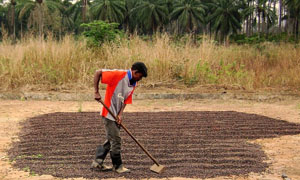You are here » Home » Telling Our Story
Success Story
Foreign order for 300 metric tons brings bean back into the spotlight
Shipment May Signal Coffee’s Rebirth

Photo: CLUSA/R. Gonçalves
A farmer in Gabela, Kwanza Sul Province, dries coffee in a field after harvest. A USAID-funded program is supporting local farmers as they strive to make coffee competitive once again.
A USAID-funded program in Angola, once a coffee powerhouse, is connecting foreign companies with the country’s resuscitated coffee industry.
Toward the end of the colonial era, Angola was an agricultural powerhouse. Self-sufficient in food production, the country was also the world’s fourth largest exporter of coffee. Today, coffee is like a fond memory among Angolans, whose coffee fields were abandoned during the war, many replaced with crops such as maize and cassava. However, a sign of recovery for this industry glimmered when Angola made its first shipment of coffee to Europe after many years.
A USAID-funded program facilitated a visit by CTCS, a brokerage trading company in Seven Oaks, England, to Angola. The firm, which supplies coffee retailers such as Starbucks and Marks and Spencers Roasters, placed a trial order for 300 metric tons of commercial grade Amboim robusta beans from Kwanza Sul Province. Robusta is used as a filler, and is blended with arabica beans for brewing.
In Angola, a major challenge facing coffee growers is how to make the crop profitable, in comparison with others such as plantains, potatoes, and pineapple. To help 4,000 former farmers restore abandoned or underutilized coffee farms, the program is providing organizational development assistance and is facilitating access to bank loans and markets. Altogether, it has organized and trained 82 farmer associations and 11 management committees that represent 2,222 coffee smallholders, and has facilitated over $1.2 million of credit. To help open new market opportunities for Angolan coffee and market robusta as a specialty coffee, the program also wants to engage more international coffee traders in evaluating its export potential and in discussing strategies for rehabilitating the coffee industry.
CTCS hopes to export around 500 metric tons of coffee. With improvements in production and post harvest handling and processing, CTCS said that it can conceivably export as much as 1,500 metric tons annually.
Print-friendly version of this page (533kb - PDF)
Back to Top ^
|




